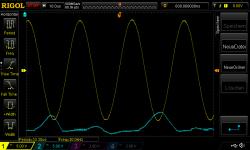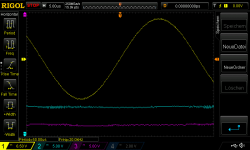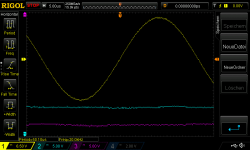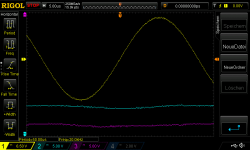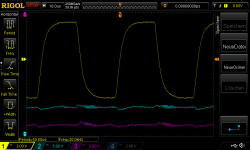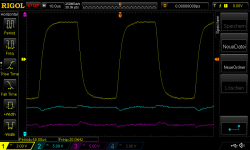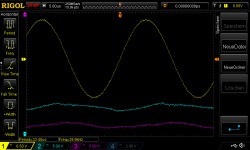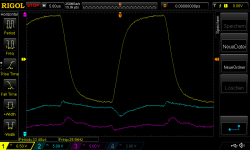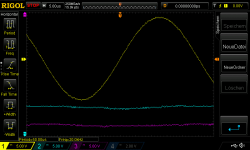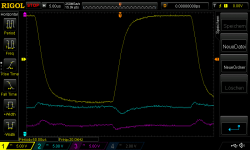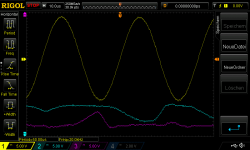2 volts seems huge to me at the input
OK, I tried with less, the power supply was also too weak. Now I powered from regulator board with 40V, at 30kHz and with 60pF in the miller, with 470/150 and 390/680 I get this from the 15003s from 1.3V sine input which equals 130W into 8R with 1uF added (the blue trace is the output of the regulator board):
Attachments
I have a strange question: I don't have a speaker connected, but I can hear the input signal coming from my PCB! Every frequency between 1kHz and 15kHz is clearly radiated from the circuit if I input something like 1V. I tried to touch all parts with the rubber end of a pencil, but couldn't find where it comes from. The Naim board is dead silent...
zobel network?I have a strange question: I don't have a speaker connected, but I can hear the input signal coming from my PCB! Every frequency between 1kHz and 15kHz is clearly radiated from the circuit if I input something like 1V. I tried to touch all parts with the rubber end of a pencil, but couldn't find where it comes from. The Naim board is dead silent...
I redid the tests and you are right if we push a little on the input we see again phase problems that appear.
So I redid the settings with the BUV 22 to no longer have any phase problems up to at least 1 volt. it works but on the other hand with a capacity in parallel the amp is much less stable even if it holds on 1UF
I get these values:
R25 2000
A27: 150
R26:470
R30:1000
They may not be the best values.
With the MJ15024 I get a good result, however I notice a little crossover distortion from 15,000 hz as on the BUV22.
The best values I've found are:
R25 2000
R26,680
R27,560
R30 620
With these values I mount the amp at 1.6 volts input without phase problem but it clips at 1.7 volts
I redid the tests with the Mj15003 and with the original values there appear phase problems from 300mvolts in input by making a minimal adjustment just by passing R30 to 200 ohms no more problem we go up to 1.4 volts without problem at 1.5 volts the phase problem reappears slightly but we are at high power
crossover distortion appears around 30,000 hz
You can also use R25 2000, R26 680, R27 560, R30 390 the result is the same with Mj15003
So I redid the settings with the BUV 22 to no longer have any phase problems up to at least 1 volt. it works but on the other hand with a capacity in parallel the amp is much less stable even if it holds on 1UF
I get these values:
R25 2000
A27: 150
R26:470
R30:1000
They may not be the best values.
With the MJ15024 I get a good result, however I notice a little crossover distortion from 15,000 hz as on the BUV22.
The best values I've found are:
R25 2000
R26,680
R27,560
R30 620
With these values I mount the amp at 1.6 volts input without phase problem but it clips at 1.7 volts
I redid the tests with the Mj15003 and with the original values there appear phase problems from 300mvolts in input by making a minimal adjustment just by passing R30 to 200 ohms no more problem we go up to 1.4 volts without problem at 1.5 volts the phase problem reappears slightly but we are at high power
crossover distortion appears around 30,000 hz
You can also use R25 2000, R26 680, R27 560, R30 390 the result is the same with Mj15003
Last edited:
With the MJ15024 I get a good result, however I notice a little crossover distortion from 15,000 hz as on the BUV22.
The best values I've found are:
R25 2000
R26,680
R27,560
R30 620
Did you also try 470/150 and 560/680 with the 15024s?
I redid the tests with the Mj15003 and with the original values there appear phase problems from 300mvolts in input by making a minimal adjustment just by passing R30 to 200 ohms no more problem we go up to 1.4 volts without problem at 1.5 volts the phase problem reappears slightly but we are at high power
crossover distortion appears around 30,000 hz
You can also use R25 2000, R26 680, R27 560, R30 390 the result is the same with Mj15003
I don't understand: 15003 is better with 390 or 200 Ohms in R30? I just tried both values and found no difference...
Here some of my scope shots: 01 is the Naim board with the Naim regulator board, 02 is my clone (with 15003s) on the Naim regulator, 03 is my clone on Jeff's inverted regulator circuit. Values are 39pF, bias across 2 emitter resistors was set to 7.2mV, compensation network with standard resistor values. The blue trace is the positive supply rail, purple is the negative supply rail, yellow is at the output with speaker cable connected, 8R load and 1uF in parallel. The Naim regulator shows flat supply rails, the inverted regulator board shows some minor wobble (the Naim regulator only starts to wobble a bit if I go further up to 1.5 or 1.6V input).
Attachments
I don't think R25 changes the sound. It's only for idle Bias current (my schematic shows it's 2k7. But I don't think I used 2k7). If you use degeneration resistors. it solves most of the oscillation problems. Do you use? If you use and you can test, try 22ohm degeneration resistors. Oscillation can start, control it. I know that THD decrease with 22ohm value. for 10-15ohm oscillation really starts then R5&C5 will be really necessary.
do you observe any difference in sound with regulator?And here a 0.5V square wave of 20kHz into the same 8R / 1uF load:
Generally speaking I find the traditional regulated Naim amps far superior compared to the unregulated models.
I plan to test regulated front end with raw powered output stage, that's an interesting option. Here is the high voltage Jung style super regulator the guys over there helped me to put together. Many on that forum report that a regulated front end offers the best of both worlds: dynamics of raw supply married with refinement of regulated supply.
But the best modern Naim amps have both stages regulated separately. So I will try the regulated power stage powered from Jeff's inverted regulator with the input stage powered from my high voltage super regulator. And of course from separate transformers
I plan to test regulated front end with raw powered output stage, that's an interesting option. Here is the high voltage Jung style super regulator the guys over there helped me to put together. Many on that forum report that a regulated front end offers the best of both worlds: dynamics of raw supply married with refinement of regulated supply.
But the best modern Naim amps have both stages regulated separately. So I will try the regulated power stage powered from Jeff's inverted regulator with the input stage powered from my high voltage super regulator. And of course from separate transformers
Last edited:
Own boards conception on Kicad but made buy JLCPCB factory.Where did you guys get the boards from?thank you
jpk73 your board seems very stable, and to answer to mdardeniz i don't use degeneration resistors because i had respect original shematic of naim.
For MJ15024 i try the two combinaisons (560/680 and 150/470)
For the MJ15003 the two combinaisons i mentionned works identically.
on my board there is a little problem of phase compensation with 300mv but my board is different of your's so maybe with your board original values works fine with MJ15003.
In few days i will do tests with 2n6341 outputs and i have to redo tests of the regulated board too.
I also don't use degeneration resistors. I made some tests with my BUV21s: I can confirm Cristobools values of 39pF, 150/470 and 1K/680, and as he said the BIAS needs to be cranked up - in order to get rid of cross over distortion I needed 70mV idle - way too high, but the signal looks fine up to 30kHz and up to 130W into 8R/1uF:
Attachments
And here with normal bias (7.2mV) at reduced power (1V input). Very faint cross over distortion is visible from 15kHz as Cristobool said, but as it appears only at higher power and frequency I guess a stronger driver should solve the distortion (first pictures with Naim regulator, second pictures with Jeff's inverted regulator):
Attachments
Last edited:
This is probably why some clones using the BUV21 use MJ15032/33
It is a solution to be tested.
As for my amplifier with the 2N6341G I hope not to have too many problems I had not understood the origin of the problem and as it seemed to pass by putting the regulator upstream or by twisting the power supply wires I I was thinking of a noise problem but I had it all wrong, I would like to keep the same transistors (output/drivers) because the result in terms of audio quality is really good.
It is a solution to be tested.
As for my amplifier with the 2N6341G I hope not to have too many problems I had not understood the origin of the problem and as it seemed to pass by putting the regulator upstream or by twisting the power supply wires I I was thinking of a noise problem but I had it all wrong, I would like to keep the same transistors (output/drivers) because the result in terms of audio quality is really good.
it's an interesting approach even if we're no longer into pure naim clones, it's definitely something to try. I also agree with you on the audio qualities of a properly regulated amplifier, the power quality of an amplifier has a lot to do with its audio quality. In the end I know very few amplifiers with large power supply regulations like Naim does, I have seen accuphases with good regulations also maybe Krell too it seems to me.Generally speaking I find the traditional regulated Naim amps far superior compared to the unregulated models.
I plan to test regulated front end with raw powered output stage, that's an interesting option. Here is the high voltage Jung style super regulator the guys over there helped me to put together. Many on that forum report that a regulated front end offers the best of both worlds: dynamics of raw supply married with refinement of regulated supply.
But the best modern Naim amps have both stages regulated separately. So I will try the regulated power stage powered from Jeff's inverted regulator with the input stage powered from my high voltage super regulator. And of course from separate transformers
- Home
- Amplifiers
- Solid State
- NAIM NAP250 Original clone build thread
